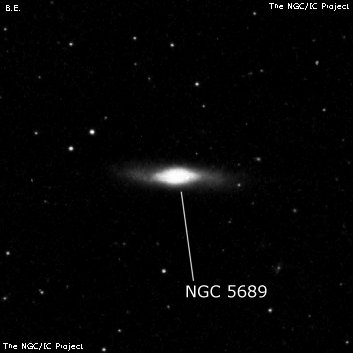
William Herschel discovered NGC 5689 = H I-188 = h1848 on 12 May 1787 (sweep 734) and recorded "cB or pB, mbM, lE in the direction of the parallel, about 1 1/2' long." He observed this galaxy again 3 nights later (sweep 736) and called it "pB, mbM, E in the parallel with faint branches." JH made the single observation "B; S; pmE; psbM; pos nearly in the parallel." His position and description matches UGC 9399. George Stoney made a sketch on 13 Apr 1850 with LdR's 72".
200/250mm - 8" (4/24/82): fairly faint, small, elongated E-W, bright core.
300/350mm - 13.1" (3/24/84): fairly bright, distinctive very elongated streak E-W, fairly small, small bright nucleus. Brightest in a group including NGC 5682 and NGC 5693.
400/500mm - 17.5" (6/27/98): fairly bright, moderately large, very elongated 4:2 WSW-ENE. The tips of the extensions fade into the background but appear ~2.2'x0.5' with averted vision. Sharply concentrated with a well-defined bright core. With direct vision, a quasi-stellar or stellar nucleus is visible at times. Brightest of five in a group with NGC 5682, NGC 5683, NGC 5693 and NGC 5700.
Notes by Steve Gottlieb